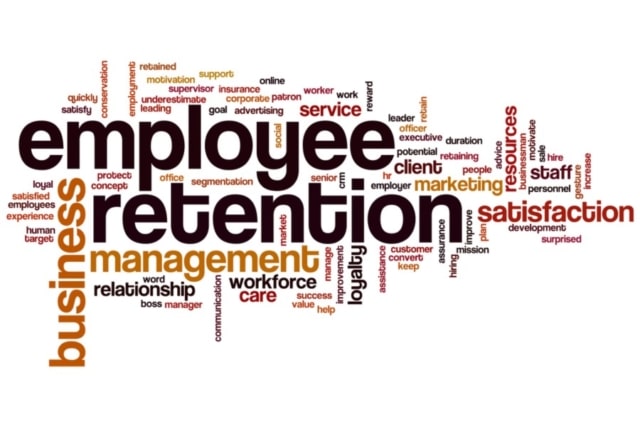In this article, we'll cover:
Employees are the beating heart of any business. It is also employees who are the direct link between the product and the customer. This can be at the point of sale or when a customer asks for technical support.
Any business owner knows that retaining good employees makes their organisation stronger. And many companies, particularly small businesses, see their employees as family.
But things do not always go smoothly. Employees leave for a variety of reasons, from better offers to job dissatisfaction. Recognising why your attrition rate is the rate it’s at means that you can take action to hopefully lower it. But just what does an attrition rate mean? And what can you do to positively impact it?

What is an attrition rate?
Put at its simplest, your employee attrition rate – or churn rate – is the rate at which employees leave your company. It’s often calculated as an annual figure or as a number of employees over another time frame. It is usually given as a percentage figure. So, for example, if your company has 100 employees and ten employees leave in the course of a year, then you have an attrition rate of 10%.
Some attrition is natural and unavoidable. Other forms of attrition occur due to particular circumstances. Being able to break down your attrition figures, knowing what the average number of employees leaving is, and addressing any issues that affect them can go a long way to improving that rate in the future.
Main types of attrition
- Voluntary attrition
This can cover several scenarios where employees leave. It may be that a number of individuals have reached retirement age or that they are relocating away from your business location. It may also be that they have received a better job offer or that they have left due to dissatisfaction at work. It can also cover voluntary redundancy where your business has had to make job cuts.
- Involuntary attrition
This refers to a scenario where there is little choice. It happens when an employee is sacked from your company for a range of reasons which can include disciplinary action or misconduct. It may also include incidences of layoffs where job cuts are forced on a section of the workforce. For example, your organisation is downsizing in some areas.
- Internal attrition
A slightly more complicated scenario. This would normally only apply to larger organisations where you may want to calculate attrition rates on specific teams or departments. If a staff member moves from one department to another, then this can be viewed as internal attrition.
- Demographic attrition
This is a scenario that may be of particular concern to a business. It happens when a specific demographic group (age, gender, race, disability) chooses to leave your company. It could indicate that you do not have suitable diversity or support policies in place. If you have a high attrition rate in this area, then you should investigate it immediately.

Rate of attrition formula
Being able to express any attrition rates within your company as a simple numerical value is essential when it comes to highlighting any issues that may exist. By focusing on any issues that are creating high attrition, you can hopefully remedy those problems and see a decrease in attrition rates in the next cycle.
As you can see from the image above, there’s a fairly simple formula. You divide the number of people that have left your employ by your total number of employees in that period, then multiply by 100.
To give an example: your workforce totals 2,500 people. In a period of one year, 63 staff leave for whatever reason. By dividing 63 by 2,500 and multiplying the answer by 100, you calculate an annual attrition rate of 2.52%.

Pros and cons of attrition rate
It would be too easy to think of attrition as a purely negative thing. The fact is, some attrition can be positive and some can be negative. Being able to analyse not only your actual attrition rate but also the reasons for it, will let you see which employee departures may have had positive effects and those that haven’t.
Pros of attrition
- Reduced costs. In some cases, you may have employees who have been with you for a significant period of time and who have moved up the pay scales. But they may be earning a lot more than other team members doing the same job, with the same efficiency. If those staff members leave, it can see a reduction in your wage bill and improved bottom line, even if you have to replace them.
- Refreshing the talent pool. When employees leave and new employees join, it can lead to a renaissance of ideas within your business. Bringing in new talent can lead to innovation and progress for different areas of your business.
- Performance improvement. Similar to refreshing the talent pool, shedding workers who may have become complacent and affected productivity can lead to an increase in productivity when new employees join. This can have wide-ranging effects across your company.
- Losing negative influences. There are often times when a staff member is just not a good fit in your organisation. They may be a poor worker or commit frequent disciplinary breaches. Losing them will likely have only positive effects.
- Bad fit. You have worked hard to establish a specific company culture that reflects well on your product or brand. There are often cases where someone is just not a good fit with that culture, and their negativity can impact the company as a whole. Losing that employee often helps reinforce your culture.
Cons of attrition
- Decreased productivity or performance. Unplanned attrition can adversely affect your organisation’s productivity and performance. Losing someone who may be an integral part of your workforce may not only leave you with a lower headcount, it may also have negative effects on customer attrition rates and relationships.
- Increase in costs. When an employee leaves and you need to replace them, there can be various costs as a result. You may have to make payments to the departing employee, then source, hire, and train a new member of staff
- Loss of knowledge. This is a particular negative when you lose someone who has been a long-term employee. They know your systems, processes, and culture. Bringing someone new up to speed takes time and can have various negative effects.
- Sudden departures. In most cases, a business will have a period of notice when an employee intends to leave. This allows time to hire a replacement and begin training. But when an employee leaves suddenly, it can leave a gap that may affect certain daily tasks or ongoing projects.
- Negative perception. If a company has a persistently high attrition rate, it may affect the trust your customers have in and how the public perceives your brand or business. It can also have an effect on your hiring ability as people may be more cautious about joining a company with a known high attrition rate.
- Career development. Most businesses invest both time and money in the career development of their staff. Internal and external training costs money, and if you have high rates of attrition then not only is that investment wasted, but you also have to repeat the cycle with new staff.

What’s the difference between attrition and turnover?
This is an area that often causes confusion. Are attrition and turnover rates the same thing? Should you be more concerned about one or the other? Knowing how to differentiate between the two is a crucial element in knowing when you have to take some sort of action.
Your staff turnover rate is best described as the rate of one-for-one staff replacements over the course of a defined period of time. You should only count turnover as those instances when you replace a departing staff member with a new one.
While attrition includes employees who leave and are replaced, it also accounts for those who aren’t replaced. What’s important is that you identify any underlying reasons for either turnover or attrition, and take remedial action where required.
How to lower your attrition rates
Whether there is a need to lower your attrition rate will very much depend on how high it is and the reasons for it. Any business should expect some natural level of attrition and in those cases, there will likely be no need for action. But if your attrition rate is high, then further action may be needed.
Once you have calculated your attrition rate then your next step is to look at the reasons behind departures. Where instances are caused by internal attrition and are mostly of the voluntary kind, then there is little you can do. However, if voluntary attrition was due to dissatisfaction or leaving for a better job, then look closer. Identify what metrics affect your attrition.
If you do see that you have worrying levels of attrition, what can you do to slow or even reverse the trend?
- Monitor employee satisfaction
The basic fact is that a happy employee is more likely to remain with a company than an unhappy one. By prioritising employee satisfaction, you should see a lower attrition rate. Ensure there are good avenues of communication and employee engagement, where employees can voice grievances to management.
- Pay structures & bonuses
Any employment market is competitive, and people will leave an organisation if they feel – or know – that they can be better compensated elsewhere. It pays to keep abreast of what the wage and bonus structure looks like with your competitors.
- Think ahead
Some new employees may see your business as a temporary waypoint. Others may look at their role as long-term or for life. By having a good recruitment process, you may be able to lower future attrition rates and identify the candidates who see you as a long-term employer rather than a stopgap. Ask new hires pertinent questions, check their Linkedin, etc.
- Exit interviews
When employees leave – unless their contracts are terminated or they are retiring – you should always hold an exit interview. This can give you better insights into how employees see your business.
- Act on issues, change policies
It may sound obvious, but if you do identify issues, act to remedy them. There is little point in knowing what the problem is if you do not take steps to make the situation better. Sometimes it may not be something you realised was an issue. But if you take action, then you will likely see lower attrition rates later.
- Flexibility
Being able to offer flexibility will vary according to your business model. Not all roles can work from home, but you can look at things like flexi-time working, adaptable shift patterns, etc. Listening to what your employees want and monitoring what your competitors offer can help you make similar decisions.

The takeaway
Losing employees and having to replace them is not only an inconvenience, but it is also an added expense. Research has shown that the average cost to replace an employee (based on the earning £25k or more) is around £30K. So if you have high rates of attrition, you can see just how much that will add to your outgoings.
But losing and replacing employees incurs not only financial costs, but it can also have negative effects on customer relationships and how people perceive your organisation. Too many businesses focus outwards on their markets and lose sight of what is going on within their company structure.
Pay close attention to your attrition rates. If the rate is high, then look at the reasons for it and take any appropriate action. Good employee retention rates mean you have a low attrition rate and a happy workforce. A happy workforce means you are more likely to have good productivity, satisfied customers, and a healthy revenue stream.
Originally published May 12, 2021, updated Feb 05, 2023

